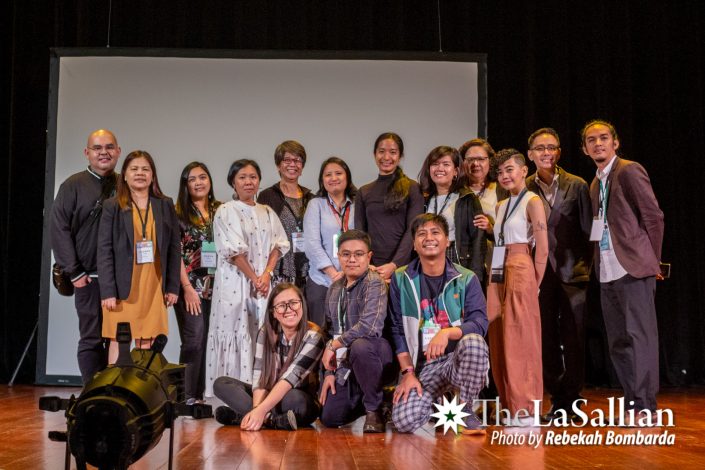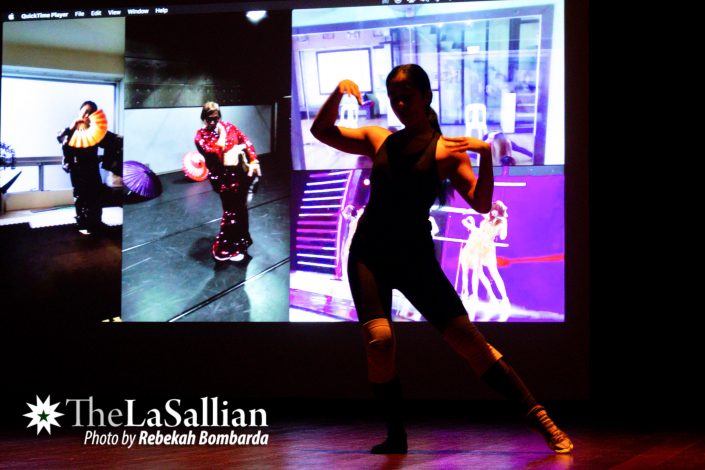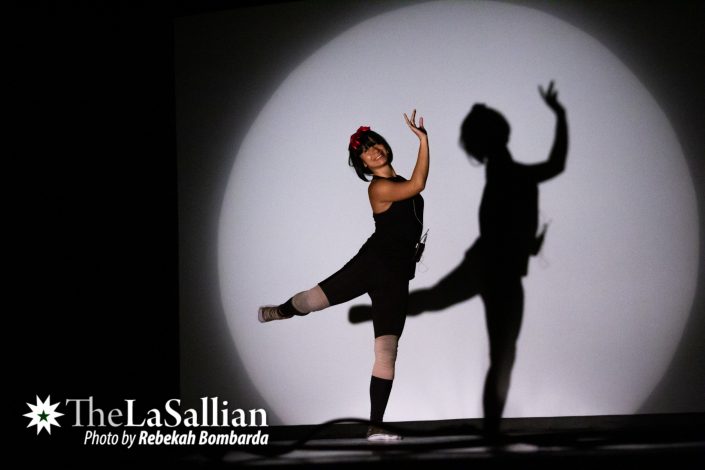Snow White asked me to write this.
Mind you, this was no ordinary Disney Princess. This was a high heel boot kicking, K-pop dancing, macho posing Disney Princess—an embodied mishmash of personalities. Save for her sing-song pitch and red bow around her hair, she resembled a fitness instructor much more.
The dissonance between her persona and appearance unsettled many in the crowd. Still, here she was, in full character, making small talk with the audience and waltzing between the rows of the Teresa Yuchengco Auditorium. Reaching me, she settled into an adjacent empty seat and asked me what I do. I mentioned that I was part of the school publication.
“You should write about this,” Snow White said, before tip-toeing to the next row in perfect princess fashion.
This was just another moment of supreme unrealism in Eisa Jocson’s Corponomy. Off the stage, she is the critically acclaimed choreographer and dancer. But on stage—delivering the keynote address for the Department of Literature’s Populism and the Popular in Arts and Culture conference last March 7—Jocson was in complete control of her craft. Here, Jocson transcended her individuality to become whoever she desired: a pole dancer, a macho dancer, a hostess—and yes, a princess.
The show begins
Rather than taking the form of a regular talk, Jocson chose a different route, one she had first showcased in the brightest of lights: Singapore’s Esplanade-Theatres on the Bay. It was Corponomy, an hour-long performance lecture that documented the training and preparation Jocson underwent for each of four role transformations.
It began with the body of Jocson casting long shadows. With her back to the audience, she warmed up—bopping with a lightness to her step. Her silhouette moved in exaggerated motions against the white projector screen, like a gaping black canvas through which she morphed into character. Then, wordlessly, she walked to the table and began to type on her laptop, and the projector screen flashed the words she wrote.
“Hello. I’m White,” it said.
There was an appeal and intimacy to this “meta” format. Throughout the course of the performance lecture, Jocson never spoke. She communicated through her laptop.
To reconstruct the process from preparation to performance, Jocson first introduced the concept through brief explanatory paragraphs on screen. She then set up a collage of instructional clips and home videos pulled from her personal archive. With the videos as her backdrop, she stepped into character and danced.
The body, weaponized
For her first performance—Death of the Pole Dancer—Jocson chronicled the transformation and normalization of pole dancing from a red light district activity into a socially accepted fitness routine. The background screen paralleled a ballet workout video and clips of her own pole dance performances. On stage, Jocson followed the workout regime before gradually modifying her movements into pole dancing steps, a departure from the formality of ballet. In Macho Dancer, Jocson rejected gender-imposed stereotypes by channeling the masculinity of macho dance through a female body. Immediately after, she transformed again, this time exploring how Filipinas in Japan become objectified and exploited dancers in Hostess.
But among all her performances, it was her final act that drew the audience in the action—quite literally. Princess explored the alienation felt by Filipino entertainers working in the likes of Disneyland. Assuming the role of Snow White, Jocson slipped into a foregin creation entirely removed from her own culture. In this newfound identity, she broke the fourth wall, walking among the audience and transferring them from their comfortable role as passive witnesses to involved actors.
Right after, Jocson pranced back up the stage before tripping under the spotlight. Suddenly robbed of her composure and in total self-awareness of the situation, the disgraced Snow White mumbled, “I’m awfully sorry. I didn’t mean to frighten you.” She proceeded to repeat a monologue lifted from the Disney film while her body contorted in the suddenly-alien dances she had previously performed. Eventually, her movements slowed and ceased as she uttered the words: “But you don’t know what I’ve been through.”
Perhaps it was this that stirred greater unease among the audience—that is, not so much the mismatch between persona and performer, but the intimate interaction and subsequent breakdown which forced them to acknowledge the humanity beyond an entertainer’s polished smiles.
This talent to manipulate the audience’s emotions was what made Jocson’s performances so captivating. Every stiff, angular step, every gleeful swing of the arm was purposeful. Through these movements, Jocson’s body became an instrument.

With every role, she invited the audience to reflect on the socioeconomic factors that defined pole dancers, macho dancers, Filipino hostesses in Japan, and Filipino dancers in Disneyland. Jocson’s own process of transformation into the role humanized these often unheard voices—affirming that the true power of Corponomy is in its ability to linger in the observer long after the final dance.


